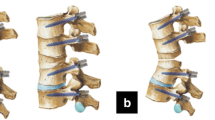Abstract
Objective
To explore the surgical outcome of patients with degenerative lumbar kyphoscoliosis who underwent multilevel extended posterior column osteotomy (PCO) plus unilateral cage strutting (UCS).
Methods
From Jan 2012 to Aug 2017, 23 patients with degenerative lumbar kyphoscoliosis who underwent multilevel extended PCO plus UCS technique (study group) and 13 patients who underwent asymmetrical pedicle subtraction osteotomy (PSO) technique (control group) were retrospectively reviewed; the radiological features, including coronal/sagittal deformity, and clinical evaluation including Oswestry Disability Index (ODI), visual analog scale (VAS), and Japanese Orthopedic Association (JOA) scores-lumbar were assessed before surgery and at follow-up.
Results
All patients underwent the operation successfully. There was no difference in fusion level, blood loss, and follow-up duration between the two groups; the operation time and length of hospital stay were shorter in study group than that in control group. All patients achieved significant correction of both scoliotic and kyphotic deformity and maintained the correction at minimum of two year follow-up, without any difference in deformity correction and correction loss between the two groups. All patients got back pain and leg pain alleviation and neurological function improvement at two year follow-up, without any difference between the two groups. The incidence of complications was lower in study group than that in control group.
Conclusion
Multilevel extended PCO plus UCS procedure could achieve significant correction of scoliosis and kyphosis in the treatment of degenerative lumbar kyphoscoliosis, presenting less surgery time, lower incidence of complication, and shorter hospital stay when compared with the asymmetric PSO technique.




Similar content being viewed by others
References
Hasegawa K, Homma T (2003) One-stage three-dimensional correction and fusion: a multilevel posterior lumbar interbody fusion procedure for degenerative lumbar kyphoscoliosis. Tech Note J Neurosurg 99(1 Suppl):125–131
Raman T, Passias PG, Kebaish KM (2019) Asymmetric three-column osteotomy for coronal malalignment in adult patients with prior thoracic fusion for adolescent idiopathic scoliosis: three-year follow-up. World Neurosurg 131:e441–e446
Matsumura A, Namikawa T, Kato M (2017) Posterior corrective surgery with a multilevel transforaminal lumbar interbody fusion and a rod rotation maneuver for patients with degenerative lumbar kyphoscoliosis. J Neurosurg Spine 26(2):150–157
Shi B, Zhao Q, Xu L (2018) SRS-Schwab Grade 4 osteotomy for congenital thoracolumbar kyphosis: a minimum of 2 years follow-up study. Spine J 18(11):2059–2064
Schwab F, Blondel B, Chay E (2015) The comprehensive anatomical spinal osteotomy classification. Neurosurgery 76(suppl 1):S33–S41
Cecchinato R, Berjano P, Aguirre MF (2015) Asymmetrical pedicle subtraction osteotomy in the lumbar spine in combined coronal and sagittal imbalance. Eur Spine J 24(S1):S66–S71
Suzuki S, Fujita N, Hikata T (2017) Asymmetrical pedicle subtraction osteotomy for progressive kyphoscoliosis caused by a pediatric chance fracture: a case report. Scoliosis Spinal Disord 12:8
Toyone T, Shiboi R, Ozawa T (2012) Asymmetrical pedicle subtraction osteotomy for rigid degenerative lumbar kyphoscoliosis. Spine (Phila Pa 1976) 37(21):1847–1852
Chan AK, Lau D, Osorio JA (2019) Asymmetric pedicle subtraction osteotomy for adult spinal deformity with coronal imbalance: complications, radiographic and surgical outcomes. Oper Neurosurg (Hagerstown):opz106. https://doi.org/10.1093/ons/opz106
Buchowski JM, Bridwell KH, Lenke LG (2007) Neurologic complications of lumbar pedicle subtraction osteotomy: a 10-year assessment. Spine 32:2245–2252
Gill JB, Levin A, Burd T (2008) Corrective osteotomies in spine surgery. J Bone Joint Surg Am 90:2509–2520
Barrey C, Perrin G, Michel F (2014) Pedicle subtraction osteotomy in the lumbar spine: indications, technical aspects, results and complications. Eur J Orthop Surg Traumatol 24(Suppl 1):S21–S30
Bridwell KH (2006) Decision making regarding Smithe-Petersen vs. pedicle subtraction osteotomy vs. vertebral column resection for spinal deformity. Spine J 31:S171–S178
Bridwell KH, Lenke LG, McEnery KW (1995) Anterior fresh frozen structural allografts in the thoracic and lumbar spine. Spine 20:1410–1418
Cho KJ, Bridwell KH, Lenke LG (2009) Comparison of Smith-Petersen versus pedicle subtraction osteotomy for the correction of fixed sagittal imbalance. Spine 34:785–791
Seki S, Yahara Y, Makino H (2019) Differential rod contouring on thoracolumbar/lumbar curvature in patients with adolescent idiopathic scoliosis: an analysis with intraoperative acquisition of three-dimensional imaging. J Orthop Sci 24(5):780–786
Uribe JS, Schwab F, Mundis GM (2018) The comprehensive anatomical spinal osteotomy and anterior column realignment classification. J Neurosurg Spine 29(5):565–575
Schwab F, Blondel B, Chay E (2014) The comprehensive anatomical spinal osteotomy classification. Neurosurgery 74(1):112–120
Mobbs RJ, Phan K, Malham G (2015) Lumbar interbody fusion: techniques, indications and comparison of interbody fusion options including PLIF, TLIF, MI-TLIF, OLIF/ATP, LLIF and ALIF.J. Spine Surg 1(1):2–18
de Kunder SL, van Kuijk SMJ, Rijkers K (2017) Transforaminal lumbar interbody fusion (TLIF) versus posterior lumbar interbody fusion (PLIF) in lumbar spondylolisthesis: a systematic review and meta-analysis. Spine J 17(11):1712–1721
Acknowledgments
We certify that this manuscript is a unique submission and is not being considered for publication, in part or in full, with any other source in any medium.
Author information
Authors and Affiliations
Corresponding author
Ethics declarations
Conflict of interest
The authors declare that they have no conflict of interest.
Additional information
Publisher’s note
Springer Nature remains neutral with regard to jurisdictional claims in published maps and institutional affiliations.
Rights and permissions
About this article
Cite this article
Wang, H., Li, W. Multilevel extended posterior column osteotomy plus unilateral cage strutting for degenerative lumbar kyphoscoliosis. International Orthopaedics (SICOT) 44, 1375–1383 (2020). https://doi.org/10.1007/s00264-020-04632-8
Received:
Accepted:
Published:
Issue Date:
DOI: https://doi.org/10.1007/s00264-020-04632-8




